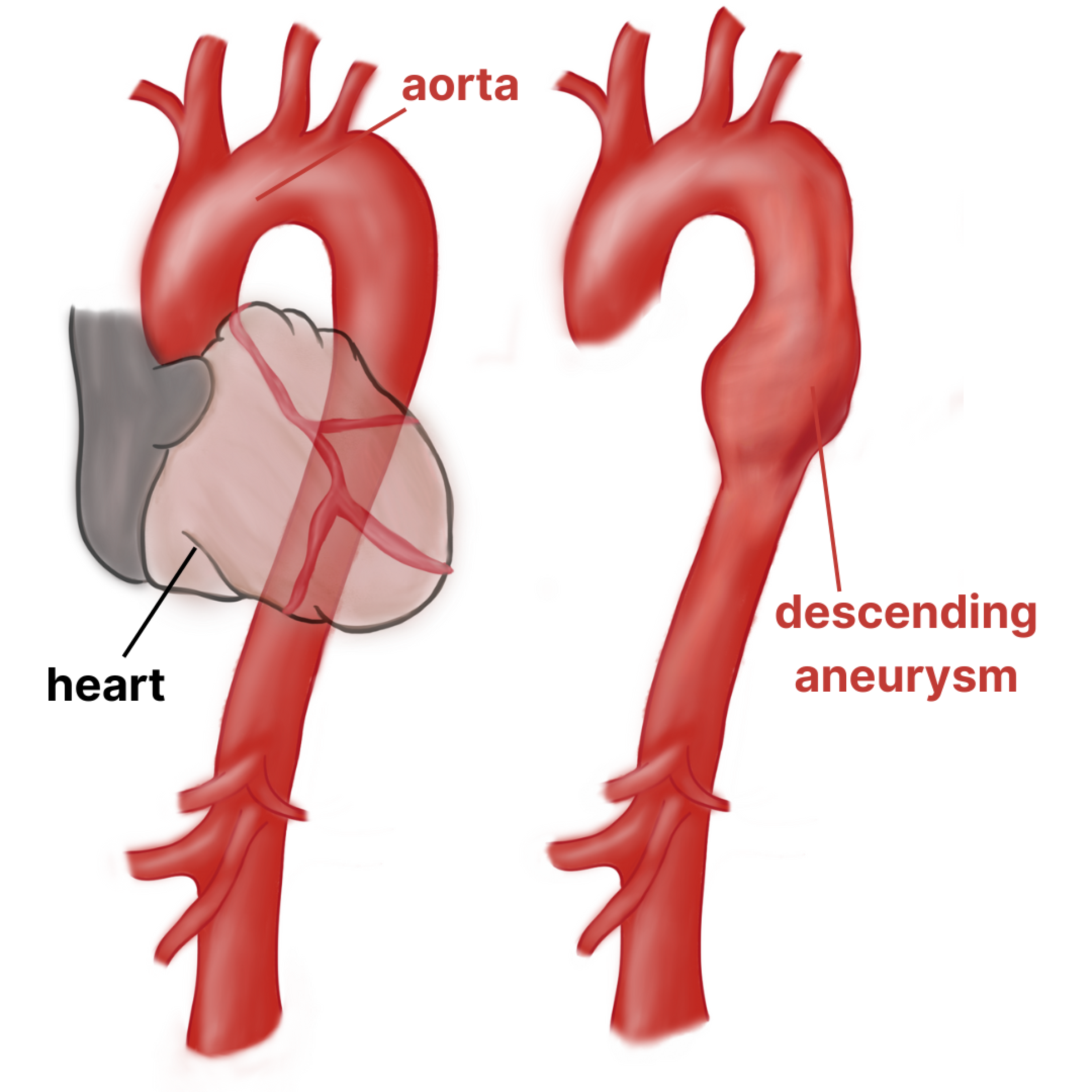Descending Thoracic Aneurysms
The aorta is the body’s largest blood vessel and is responsible for carrying blood to the rest of the body once it leaves the heart.

The thoracic aorta involves multiple aortic segments including the aortic root, ascending aorta, arch, or descending aorta. Our office specifically treats aneurysms located within the descending portion of the thoracic, whereas aneurysms in the previously mentioned segments are typically treated by a cardiothoracic surgeon since they are located closer to the heart. When there is a bulging and ballooning of the weakened aortic wall as we cross from the chest into the abdomen this is considered a descending thoracic aortic aneurysm (TAA). If left untreated or unmonitored this aneurysm much like others can grow large enough to rupture. A rupture of this aneurysm would be a serious medical emergency causing internal bleeding and possible death.
Risk Factors
There are many uncontrollable and controllable factors that put a patient at risk for TAA growth. As we age, our blood vessels begin to weaken and bulge, potentially causing an aneurysm. In addition, a family history of aneurysms is a strong predictor of aneurysm presence. Risk factors such as smoking and high blood pressure can speed up the artery weakening process and cause descending TAA’s.
- Advanced Age (over 50 years old)
- Family History of PAD, Stroke, Heart Disease
- Diabetes
- Smoking (Current smoking or history of smoking)
- High Cholesterol
- High Blood Pressure
- Coagulation disorders
- Obesity
- Personal History of Stroke, Heart Attack
Symptoms
Descending TAAs often go unnoticed as less than half of patients complain of symptoms.
If present, symptoms include back pain, chest discomfort, hoarseness, and shortness of breath. Patients with a TAA should also be aware of the signs and symptoms which may indicate rupture. If you experience any severe back pain or increased pulsatility over the chest/abdomen you may need to call 911.
Diagnosis
Due to limited symptoms associated with descending TAAs they are usually found incidentally. Here at our practice, our doctors and vascular technicians specialize in performing and examining multiple diagnostic tests to assess our patients circulation.
Computed Tomography Angiogram (CTA): This is a minimally invasive imaging technique completed at an outside facility. This involves IV contrast into your blood vessels and CT scanning to accurately evaluate the size and shape of the aneurysm.
Magnetic Resonance Angiography (MRA): This minimally invasive imaging technique uses magnetic resonance to visualize the blood vessels in your body. It may involve IV contrast into your blood vessels to allow for visualization.
ThoracicAngiogram: This is a minimally invasive procedure performed at our outpatient based lab, AccessCare Vascular. The procedure begins with a small puncture made to access the femoral arteries and guided to the artery of interest. Contrast dye is delivered through this tube. Throughout the procedure, the vascular surgeon uses real-time x-ray images and contrast dye injections to visualize the circulation and any blockage in the artery of interest.
Your descending thoracic aneurysm may also be visualized as an incidental finding during a coronary angiogram.
Treatment Options
At BEVSA, we offer both non-surgical and surgical treatment for descending aortic aneurysms. After consulting with your surgeon, they will help you decide which route is best for your disease state.
Nonsurgical Treatment: For patients with aneurysms less than 5 cm, non-surgical treatment is likely.
Risk Factor Modification: Tobacco use damages the arterial walls which makes it easier for deterioration of vessel wall. If you need help quitting smoking, our physicians will help you obtain information on medication, nicotine replacement products, and programs to make it easier
Diet and Activity: It is important to maintain a diet low in saturated fat, cholesterol, and sodium. Foods with these components can elevate cholesterol levels making it more likely for plaque to build up in the artery and increasing blood pressure.
Medication Management: Risk factors include elevated cholesterol/fat levels, type 2 diabetes, and most importantly high blood pressure. Statins have been shown to manage cholesterol/fat levels, stabilize plaque, and reduce the risk of plaque buildup. In addition patients with type 2 diabetes should engage in good glycemic control and work with their physician to achieve low levels of A1C. Adequate control of blood pressure by taking the necessary medication will decrease the force on your already weakened vessel walls which reduces risk of rupture.
Surgical Treatment: For patients with aneurysms greater than 5 cm, surgical treatment is necessary.
Thoracic Endovascular Aortic Repair (TEVAR): This is a minimally invasive surgery performed at Buffalo General Hospital for patients with a larger aneurysm. This procedure is done with a small incision made at the groin followed by delivery of a covered stent graft (like a sleeve) to the aneurysmal area using a small tube called a catheter. Once the stent is placed it is expanded to attach to the vessel walls. This procedure is a safer alternative to an open procedure and will require general anesthesia as an inpatient.
Treatment Options for Descending Thoracic Aneurysms
Thoracic Endovascular Aortic Repair (TEVAR)
TEVAR: A minimally invasive option to treat thoracic aneurysmal disease